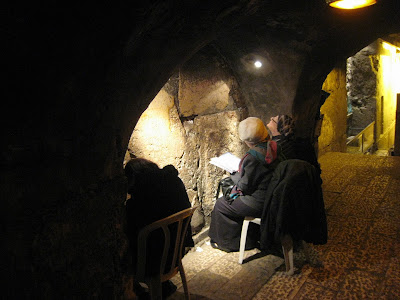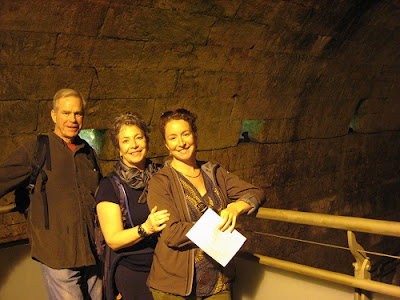One of my favourite restaurants in New York is in my old neighbourhood of Hell’s Kitchen. On 9th Avenue around 45th street (it’s been 5 years since we lived in NY, so my exact cross street knowledge is a little hazy), there is an aptly-named haunt called Turkish Cuisine. Several birthday parties and subsequent visits back to the city have taken place there. Usually, I insisted on the entire table (ranging from 2 diners up to 17) order “a lot of everything to be shared.” Communal dining is a must in certain establishments and this is one of those places. The restaurant is decorated with hundreds (potentially thousands) of Turkish lucky eyes, or "nazar boncuğu," on the walls, embedded in the tables, on the drapes, etc. The cuisine is deliciously (well…) Turkish with some embellishments thrown in there to please the tourists who have stumbled west off of the Times Square drag (tiramisu, American coffee, spaghetti) and on a warm night, there’s even a back patio to lounge away the hours, eating sigara böreği and drinking apple tea.
Admittedly, one of my favourite parts of the restaurant was one server who worked there during my tenure in New York. She was a striking woman whose formality, as a regular, puzzled me – I enjoy being a regular customer at local cafes, stores, post offices, bodegas, etc. and pride myself on being able to connect with the employees again and again, alas, she stumped me and never broke her formality during the 5 years I frequented the restaurant. I joked some and every time said something like, “Lovely to see you again,” but she stoically, yet pleasantly took our order and never cracked. She wasn’t rude, but rather untouchable. I never took offense to her mannerisms, rather, she became a fascination. She was, as I mentioned, stunning, so one was naturally drawn to her, but also efficient in such a way that even when one or more of us tripped over the pronunciation of a Turkish goodie or spilled a drink she never broke character and operated in such a way that suggested she’d anticipated our foible. As we approached our visit to Turkey, I couldn’t help by wonder if, by association, the faces of Istanbul would have the same effect as my mysterious server.
One of my favourite sports, as some have called it, is people-watching. Every place we’ve visited on this trip has included some degree of daily people-watching. I try not to stare. I try to be subtle. I usually succeed, but there has been the rare occasion when I look too long (i.e., sitting opposite someone one a train) or in an inappropriate location (i.e., a woman praying at a mosque). Wanting to write a blog about this travel pastime, I asked Steve to be my master photographer of this curiosity, especially since I had been so thoroughly enjoying the faces I’d seen so far in Istanbul: men selling street food next to the people fishing in the Bospherus, young modern women with elaborately decorated head scarves, sharply dressed businessmen in custom-tailored suits, children too young yet for traditional Islamic dress, older gents sitting around drinking Turkish coffee and playing backgammon, highly-made up vixens running to catch the street car, three generations of spice vendors in the bazaar, Istanbul hipsters drinking tea and smoking at the hidden café outlook, etc. Steve became my undercover cameraman and perfected the art of both drive-by photos as well as the “upside down shot.” Holding my hand on one side and swinging the upside down camera in his other hand, he raced me through crowds to get in front of people whose images I wanted to capture and then blindly snapped the photo behind him. Later, we needed to flip the photos on the computer (and zoom and crop and resize), but all told, we were unobtrusively able to capture images of some amazing people on the street.
 I wish we’d discovered this (sneaky) method of photography before Istanbul, since so much of our exposure to the many countries we’ve visited has been about watching the people. Not only do you learn a lot about the culture, dress, eating habits, colour codes, family dynamics, public affection customs, average sizes, builds, hair styles, usual speed of walking, interaction with others of the same sex, opposite sex, youth, elderly, foreigners (remember India?), but also you come to realize that each face is fascinating and quite beautiful in its own way. I’ve ogled so many eyes, brows, smiles, wrinkles, hair styles, piercings, noses, that I have no concept of beauty anymore since everyone seems, in their own way, uniquely gorgeous. Strip away the clothes and hair and each face in the world is incredible to look at. Also, many faces are the same – and I’m not talking about the typical Balinesian eye shape or the average Israeli’s colouring – I mean we’ve seen so many of our friends and loved ones in the faces of the people in the world that I’ve realized there are really only so many shapes and contours that the human face can take on before you find yourself face to face your childhood friend’s doppleganger in a back alley café in Nepal!
I wish we’d discovered this (sneaky) method of photography before Istanbul, since so much of our exposure to the many countries we’ve visited has been about watching the people. Not only do you learn a lot about the culture, dress, eating habits, colour codes, family dynamics, public affection customs, average sizes, builds, hair styles, usual speed of walking, interaction with others of the same sex, opposite sex, youth, elderly, foreigners (remember India?), but also you come to realize that each face is fascinating and quite beautiful in its own way. I’ve ogled so many eyes, brows, smiles, wrinkles, hair styles, piercings, noses, that I have no concept of beauty anymore since everyone seems, in their own way, uniquely gorgeous. Strip away the clothes and hair and each face in the world is incredible to look at. Also, many faces are the same – and I’m not talking about the typical Balinesian eye shape or the average Israeli’s colouring – I mean we’ve seen so many of our friends and loved ones in the faces of the people in the world that I’ve realized there are really only so many shapes and contours that the human face can take on before you find yourself face to face your childhood friend’s doppleganger in a back alley café in Nepal! For your additional viewing pleasure, I invite you to pour yourself a cup of coffee/tea and join us at a café on Refik Saydam Cad (street) in Istanbul for some people watching. The real thing couldn’t be beat – people of all colours, shapes, attitudes, and gaits wandering by and even, on occasion, glancing in at us – but in the meantime, it’s nice to share some video footage with you of the people who inhabit this city of antiquity, elegance, and mystery.
 Steve and I recommend Istanbul highly to anyone in the mood for an exotic, yet comfortable week away in a city that spans two continents (Europe and Asia), and we hope to return again sometime…with the camera flipped both right side up and upside down.
Steve and I recommend Istanbul highly to anyone in the mood for an exotic, yet comfortable week away in a city that spans two continents (Europe and Asia), and we hope to return again sometime…with the camera flipped both right side up and upside down.Post-thought: I realized as I was writing this and trying to describe some of the faces we’ve seen (not such an easy thing to do, thus relying on photographs to help), that I’ve been watching our faces change over the course of this trip as well. When you’re with a great travel buddy for 5 months, you see all sorts of changes occur in each other’s and your own faces. It’s an exciting and wacky realization! I’ve watched our faces change due to: sun exposure, fatigue, weight loss, mood related to current degree of homesickness, lighting, allergies, agreement or disagreement with the taste of food, lack of make-up (for me, people), skin dryness, presentation of information, and more. What does your face look like today and how is it different from yesterday or an hour ago? How will it look different tomorrow? How about tonight in relation to this morning? Have a look…















































